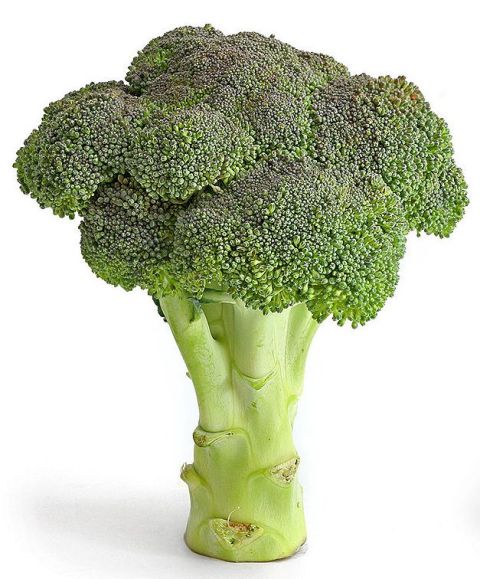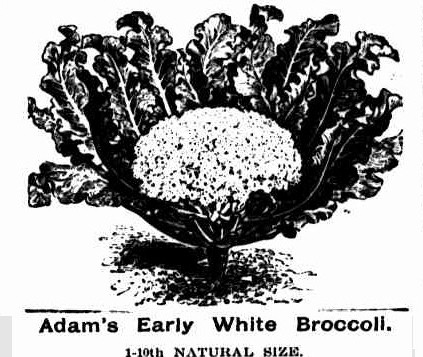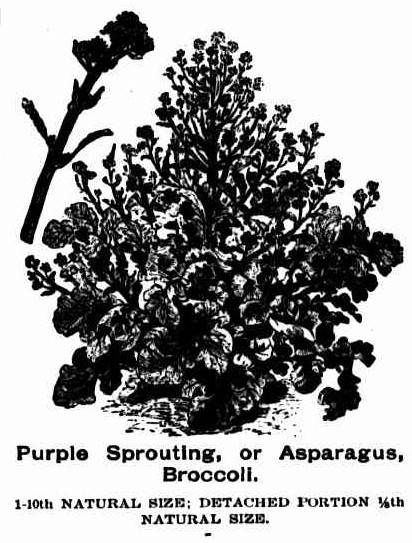September 7 - 13, 2014: Issue 179
Broccoli
The Australian broccoli crop is now coming in and with prices averaging 99 cents a kilo, a vast difference from mid-Winter’s $6.00 a kilo, it’s time to indulge in this green vegetable and all it contains to benefit your health, palate and meet what the changeover of seasons can cause to occur- sniffling noses from one minute warmish breezes to the next moment last of the snow winds wrapping invigoration around you.
 These green florets are packed with stress reducing compounds, loaded with Vitamin C and high in all you need to boosts and protect your immune system. If you don’t like the tats of plain steamed broccoli, loading this into your favourite stir fry or even trying this delicious soup will ensure you meet the season with what the soil offers up to be eaten – Australian grown and at best quality now.
These green florets are packed with stress reducing compounds, loaded with Vitamin C and high in all you need to boosts and protect your immune system. If you don’t like the tats of plain steamed broccoli, loading this into your favourite stir fry or even trying this delicious soup will ensure you meet the season with what the soil offers up to be eaten – Australian grown and at best quality now.Cream of broccoli soup
Ingredients
dash olive oil
¼ onion, finely chopped
½ head broccoli, cut into florets
salt and freshly ground black pepper
300ml/½ pint hot chicken or vegetable stock
50ml/2fl oz double cream, plus extra to serve
Heat the olive oil in a small saucepan, add the onion and fry gently until softened. Add the broccoli florets, salt and freshly ground black pepper and stock and simmer for five minutes, or until the broccoli is tender.
Stir in the cream. Blend with a hand blender until smooth. Pour into a bowl and finish with a swirl of cream.
Stir fry Broccoli with Garlic
Ingredients
500 grams broccoli
4 – 5 cloves garlic, peeled and finely chopped
2 tablespoons oil for stir-frying
Sauce:
2 tablespoons Oyster Sauce
1/4 cup Chicken broth or stock
1 tablespoon Chinese rice wine or dry sherry
1/2 teaspoon sugar
Cornflour thickener:
1 teaspoon cornflour
2 teaspoons water
Chop off the hard stems at the bottom of the broccoli. Break off the flowerets and then split them into either halves or quarters. Peel the stems and slice them diagonally into thin slices. Cook the broccoli in boiling water for about 3 minutes, until it just begins to soften and become tender but is still crisp. Drain.
In a small bowl, combine the oyster sauce, chicken broth, Chinese rice wine or dry sherry, and sugar. In a separate small bowl, stir the cornsflour into the water. Preheat the wok. To test to see if the wok is hot enough, add a few drops of water to the pan; if the water starts sizzling immediately, the wok is ready. Add oil to the pre-heated wok, tilting the wok and moving it back and forth so that the oil goes partway up the sides of the pan. When the oil is hot, add the garlic. Stir for about 10 seconds, then add the broccoli. Stir to mix with the garlic and add the sauce.
Reduce the heat to medium, cover the wok and cook for about 30 seconds. Re-stir the cornflour/water mixture and add it to the wok, stirring to thicken. Stir to mix everything together. Serve immediately.
Broccoli and Feta Frittata
Ingredients
1 tablespoon unsalted butter
1/2 onion, finely diced
2 cups chopped broccoli florets
Salt and pepper
7 large eggs
250 grams feta, crumbled
In an 8-inch/20cm ovenproof nonstick skillet melt butter over medium heat. Add onion and cook, stirring occasionally, until translucent, about 4 minutes. Add broccoli, sprinkle with salt and pepper and cook, stirring occasionally, until just tender, about 6 minutes longer until broccoli is just tender.
Preheat griller to high and set an oven rack 10cm below heat source. In a medium bowl whisk together eggs; season with additional salt and pepper. Pour eggs over onion-broccoli mixture, stir to combine, then dot surface with feta. Cook, without stirring, until eggs are set on bottom and beginning to set on top, about 5 minutes. Transfer pan to oven and grill until eggs are set and beginning to brown, 2 to 3 minutes. Cut into wedges and serve hot or at room temperature. Can also be served cold as a picnic dish!
Broccoli is an edible green plant in the cabbage family, whose large flowering head is used as a vegetable. The word broccoli comes from the Italian plural of broccolo, which means "the flowering crest of a cabbage", and is the diminutive form of brocco, meaning "small nail" or "sprout". Broccoli is often boiled or steamed but may be eaten raw. Broccoli is classified in the Italica cultivar group of the speciesBrassica oleracea. Broccoli has large flower heads, usually green in color, arranged in a tree-like structure on branches sprouting from a thick, edible stalk. The mass of flower heads is surrounded by leaves. Broccoli resembles cauliflower, which is a different cultivar group of the same species.
Broccoli is a result of careful breeding of cultivated leafy cole crops in the Northern Mediterranean in about the 6th century BC. Since the Roman Empire, broccoli has been considered a uniquely valuable food among Italians. Broccoli was brought to England from Antwerp in the mid-18th century by Peter Scheemakers.
Peter Scheemakers or Pieter Scheemaeckers II or the Younger (16 January 1691 – 12 September 1781) was a Flemish sculptor who worked for most of his life in London, Great Britain where his public and church sculptures in a classicist style had an important influence on the development of sculpture. Scheemakers is perhaps best known for executing the William Kent-designed memorial to William Shakespeare which was erected in Poets' Corner in Westminster Abbey in 1740 as well as that to John Dryden in the same church.
Broccoli is high in vitamin C and dietary fiber. It also contains multiple nutrients with potent anti-cancer properties, such as diindolylmethane and small amounts of selenium. A single serving provides more than 30 mg of vitamin C and a half-cup provides 52 mg of vitamin C. The 3,3'-Diindolylmethane found in broccoli is a potent modulator of the innate immune response system with anti-viral, anti-bacterial and anti-cancer activity. Broccoli also contains the compound glucoraphanin, which can be processed into an anti-cancer compound sulforaphane, though the anti-cancer benefits of broccoli are greatly reduced if the vegetable is boiled. Broccoli is also an excellent source of indole-3-carbinol, a chemical which boosts DNA repair in cells and appears to block the growth of cancer cells.
Boiling broccoli reduces the levels of suspected anti-carcinogenic compounds, such as sulforaphane, with losses of 20–30% after five minutes, 40–50% after ten minutes, and 77% after thirty minutes., However, other preparation methods such as steaming, microwaving, and stir frying had no significant effect on the compounds. Broccoli has the highest levels of carotenoids in the brassica family. It is particularly rich in lutein and also provides a modest amount of beta-carotene.
Broccoli. (2014, September 4). In Wikipedia, The Free Encyclopedia. Retrieved from http://en.wikipedia.org/w/index.php?title=Broccoli&oldid=624215827

Adam's Early White Broccoli.
1-10th NATURAL SIZE.
than the cauliflower, and generally have leafstalks; the veinings of its leaves are also stout-er and whiter. Its head is handsome, firm, and compact. The seed of both plants is identical in appearance.
The cultivation of the broccoli dates back to a more remote period than that of the cauliflower, as the name, at least, would lead us to infer. In Italy the name of broccoli is applied to the tender shoots which are emitted by various kinds of cabbages and turnips preparing to flower. These green and tender young shoots have, from time immemorial, been highly esteemed as a vegetable by the Italians, who, consequently be-came careful to select and cultivate only those kinds which produced the most tender shoots in the greatest abundance. The sprouting, or asparagus, broccoli represents the first form exhibited by the new vegetable when it ceased to be the earliest cabbage, and was grown with an especial view to its shoots; after this, by continued selection and successive improvements, varieties were obtained which produced a com-pact, white head, and some of these varieties weit still further improved into kinds which are sufficiently early to commence and complete their entire growth in a few months; these last-named kinds are now known by the name of cauliflowers."
SITUATION AND SOIL, &c.
Broccoli is a hardy vegetable and can be grown to perfection in the colder parts of New South Wales, as well as in many other districts. It succeeds best in a rich, deep, well-drained loam, but good heads can be produced in any good garden soil. In old, cultivated gardens, more particularly those in which the land is composed of a large percentage of humus, the roots are sometimes attacked by grubs and other enemies which cause them to club. Such land should receive a good dressing of fresh lime before any broccoli plants are set out on it. The lime should be applied at the rate of about three-quarters of a ton to the acre and lightly forked into the soil a few weeks before the planting takes place. Broccoli should never immediately follow an allied crop, such as cabbage, turnips, &c, nor should it follow carrots and beet, though it may be planted on land that has recently produced a crop of potatoes, onions, celery, peas, &c, with

Easter Broccoli.
1-10th NATURAL SIZE.
every chance of success. To produce good crops of broccoli the land should be well and deeply worked and brought to a fine tilth, and if not naturally fertile some suitable manures should be applied. Well rotted farm-yard manure is the best if it can be obtained, failing this artificial manures may be used to advantage. A good dressing of soot is beneficial to most soils; for besides acting as a fertiliser, it keeps some in-sect posts in check.
SOIL.
Broccoli seeds can be sown from January to August. The precise time to sow the seed between those periods will depend upon circumstances, local and other conditions must be 'taken into consideration, Generally speaking the seed can be sown at intervals, and in quantities according to requirements during the first three months of the year in the cooler parts of the colony, but in the warmer districts the seed had better be sown later on in the season. One ounce of good seed will produce about two thousand plants. The seed should be sown thinly and evenly in prepared beds, leaving it only very lightly covered with soil. Should the beds be in an exposed position and the sun very hot after the seed is sown, the young seedlings should be lightly shaded during the middle of the day. Care, must be taken, however, not to shade the young plants too much or they will grow spindly. During the time the young seedlings are in the seed-beds, they should be regularly watered, and kept free from weeds.
TRANSPLANTING, &o.
When the plants are large enough to handle, and - the weather is favorable, they should be transplanted from the seed-bed to their permanent positions. Some of the larger growing sorts may be set out in rows three feet apart, and the plants two and a half feet apart in the rows. The dwarfer-growing sorts may be set out in rows two feet apart, and the plants eighteen inches apart in the rows. Should dry weather set in after the planting is done, the seedlings should be watered occasionally until they become well established; then under ordinary conditions, they will be able to take care of themselves. The only attention in the way of cultivation that is required is to keep the soil -well loosened between the rows with the scarifier or hoe, and to keep the weeds down between the plants in the rows until the leaves meet, then the plants will be able to take care of themselves and smother any ordinary farm and garden weeds. Like most cultivated plants of the cabbage family there are now innumerable varieties of broccoli,but for all practical purposes they can be reduced to a few of the better known sorts. Three well'-known varieties, illustrations of which accompany this article are herewith described:
Adam's early, white broccoli.-This is a vigorous growing variety, with rather numerous longstiff, glaucous-green leaves. The head is white, very compact and hard, continuing firm for a longtime.. It is a hardy, easily grown, early variety.
Easter broccoli.-This is a very handsome, early, and distinct variety. Its leaves are not so numerous as those of most other kinds of broccoli, and have a very peculiar appearance, being rather short, and nearly triangular in shape. It is one of the best kinds, and forms a very regular head, but is rather tender.

Purple Sprouting, or Asparagus, Broccoli.
1-10th NATURAL SIZE;
NATURAL SIZE.
Purple sprouting, or asparagus broccoli.-Under this name different varieties have been cultivated; that which is now most commonly grown has both the stems and leaves of a purplish color. It produces not only in the heart but also in the axils of the leaves rather thick and fleshy, purplish shoots. These shoots are produced in succession for a long time, they are gathered as they lengthen, before the flowers open, and are used like green asparagus, from which circum-stance the plant has received the name of asparagus brocoli. In England it is estimated that there are forty different forms of sprouting broccoli grown. The illustrations and part of the three descriptions of same are after Vilmorin.
CULTIVATOR AND GRAZIER. (1896, March 28). Australian Town and Country Journal (Sydney, NSW : 1870 - 1907), p. 21. Retrieved from http://nla.gov.au/nla.news-article71243548
Broccoli is a result of careful breeding of cultivated leafy cole crops in the Northern Mediterranean in about the 6th century BC. Since the Roman Empire, broccoli has been considered a uniquely valuable food among Italians. Broccoli was brought to England from Antwerp in the mid-18th century by Peter Scheemakers.
Peter Scheemakers or Pieter Scheemaeckers II or the Younger (16 January 1691 – 12 September 1781) was a Flemish sculptor who worked for most of his life in London, Great Britain where his public and church sculptures in a classicist style had an important influence on the development of sculpture. Scheemakers is perhaps best known for executing the William Kent-designed memorial to William Shakespeare which was erected in Poets' Corner in Westminster Abbey in 1740 as well as that to John Dryden in the same church.
Broccoli is high in vitamin C and dietary fiber. It also contains multiple nutrients with potent anti-cancer properties, such as diindolylmethane and small amounts of selenium. A single serving provides more than 30 mg of vitamin C and a half-cup provides 52 mg of vitamin C. The 3,3'-Diindolylmethane found in broccoli is a potent modulator of the innate immune response system with anti-viral, anti-bacterial and anti-cancer activity. Broccoli also contains the compound glucoraphanin, which can be processed into an anti-cancer compound sulforaphane, though the anti-cancer benefits of broccoli are greatly reduced if the vegetable is boiled. Broccoli is also an excellent source of indole-3-carbinol, a chemical which boosts DNA repair in cells and appears to block the growth of cancer cells.
Boiling broccoli reduces the levels of suspected anti-carcinogenic compounds, such as sulforaphane, with losses of 20–30% after five minutes, 40–50% after ten minutes, and 77% after thirty minutes., However, other preparation methods such as steaming, microwaving, and stir frying had no significant effect on the compounds. Broccoli has the highest levels of carotenoids in the brassica family. It is particularly rich in lutein and also provides a modest amount of beta-carotene.
Broccoli. (2014, September 4). In Wikipedia, The Free Encyclopedia. Retrieved from http://en.wikipedia.org/w/index.php?title=Broccoli&oldid=624215827
Broccoli.
(By "Vegetarian.")
(See illustrations on this page.)
Vilmorin says "the broccoli, like the cauliflower, is a cultivated variety of the wild cabbage, and is grown for the sake of its head, which is produced in the same way and has the same qualities. The two plants differ somewhat in appearance, the broccoli usually having more numerous, broader, stiffer, and narrower leaves(By "Vegetarian.")
(See illustrations on this page.)

Adam's Early White Broccoli.
1-10th NATURAL SIZE.
The cultivation of the broccoli dates back to a more remote period than that of the cauliflower, as the name, at least, would lead us to infer. In Italy the name of broccoli is applied to the tender shoots which are emitted by various kinds of cabbages and turnips preparing to flower. These green and tender young shoots have, from time immemorial, been highly esteemed as a vegetable by the Italians, who, consequently be-came careful to select and cultivate only those kinds which produced the most tender shoots in the greatest abundance. The sprouting, or asparagus, broccoli represents the first form exhibited by the new vegetable when it ceased to be the earliest cabbage, and was grown with an especial view to its shoots; after this, by continued selection and successive improvements, varieties were obtained which produced a com-pact, white head, and some of these varieties weit still further improved into kinds which are sufficiently early to commence and complete their entire growth in a few months; these last-named kinds are now known by the name of cauliflowers."
SITUATION AND SOIL, &c.
Broccoli is a hardy vegetable and can be grown to perfection in the colder parts of New South Wales, as well as in many other districts. It succeeds best in a rich, deep, well-drained loam, but good heads can be produced in any good garden soil. In old, cultivated gardens, more particularly those in which the land is composed of a large percentage of humus, the roots are sometimes attacked by grubs and other enemies which cause them to club. Such land should receive a good dressing of fresh lime before any broccoli plants are set out on it. The lime should be applied at the rate of about three-quarters of a ton to the acre and lightly forked into the soil a few weeks before the planting takes place. Broccoli should never immediately follow an allied crop, such as cabbage, turnips, &c, nor should it follow carrots and beet, though it may be planted on land that has recently produced a crop of potatoes, onions, celery, peas, &c, with

Easter Broccoli.
1-10th NATURAL SIZE.
SOIL.
Broccoli seeds can be sown from January to August. The precise time to sow the seed between those periods will depend upon circumstances, local and other conditions must be 'taken into consideration, Generally speaking the seed can be sown at intervals, and in quantities according to requirements during the first three months of the year in the cooler parts of the colony, but in the warmer districts the seed had better be sown later on in the season. One ounce of good seed will produce about two thousand plants. The seed should be sown thinly and evenly in prepared beds, leaving it only very lightly covered with soil. Should the beds be in an exposed position and the sun very hot after the seed is sown, the young seedlings should be lightly shaded during the middle of the day. Care, must be taken, however, not to shade the young plants too much or they will grow spindly. During the time the young seedlings are in the seed-beds, they should be regularly watered, and kept free from weeds.
TRANSPLANTING, &o.
When the plants are large enough to handle, and - the weather is favorable, they should be transplanted from the seed-bed to their permanent positions. Some of the larger growing sorts may be set out in rows three feet apart, and the plants two and a half feet apart in the rows. The dwarfer-growing sorts may be set out in rows two feet apart, and the plants eighteen inches apart in the rows. Should dry weather set in after the planting is done, the seedlings should be watered occasionally until they become well established; then under ordinary conditions, they will be able to take care of themselves. The only attention in the way of cultivation that is required is to keep the soil -well loosened between the rows with the scarifier or hoe, and to keep the weeds down between the plants in the rows until the leaves meet, then the plants will be able to take care of themselves and smother any ordinary farm and garden weeds. Like most cultivated plants of the cabbage family there are now innumerable varieties of broccoli,but for all practical purposes they can be reduced to a few of the better known sorts. Three well'-known varieties, illustrations of which accompany this article are herewith described:
Adam's early, white broccoli.-This is a vigorous growing variety, with rather numerous longstiff, glaucous-green leaves. The head is white, very compact and hard, continuing firm for a longtime.. It is a hardy, easily grown, early variety.
Easter broccoli.-This is a very handsome, early, and distinct variety. Its leaves are not so numerous as those of most other kinds of broccoli, and have a very peculiar appearance, being rather short, and nearly triangular in shape. It is one of the best kinds, and forms a very regular head, but is rather tender.

Purple Sprouting, or Asparagus, Broccoli.
1-10th NATURAL SIZE;
NATURAL SIZE.
CULTIVATOR AND GRAZIER. (1896, March 28). Australian Town and Country Journal (Sydney, NSW : 1870 - 1907), p. 21. Retrieved from http://nla.gov.au/nla.news-article71243548
Copyright Pittwater Online News, 2014. All Rights Reserved.